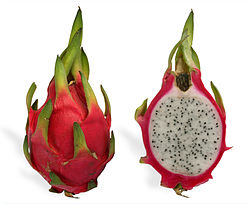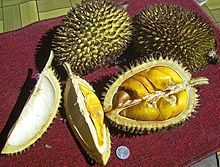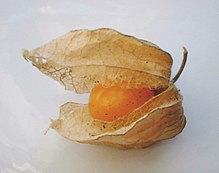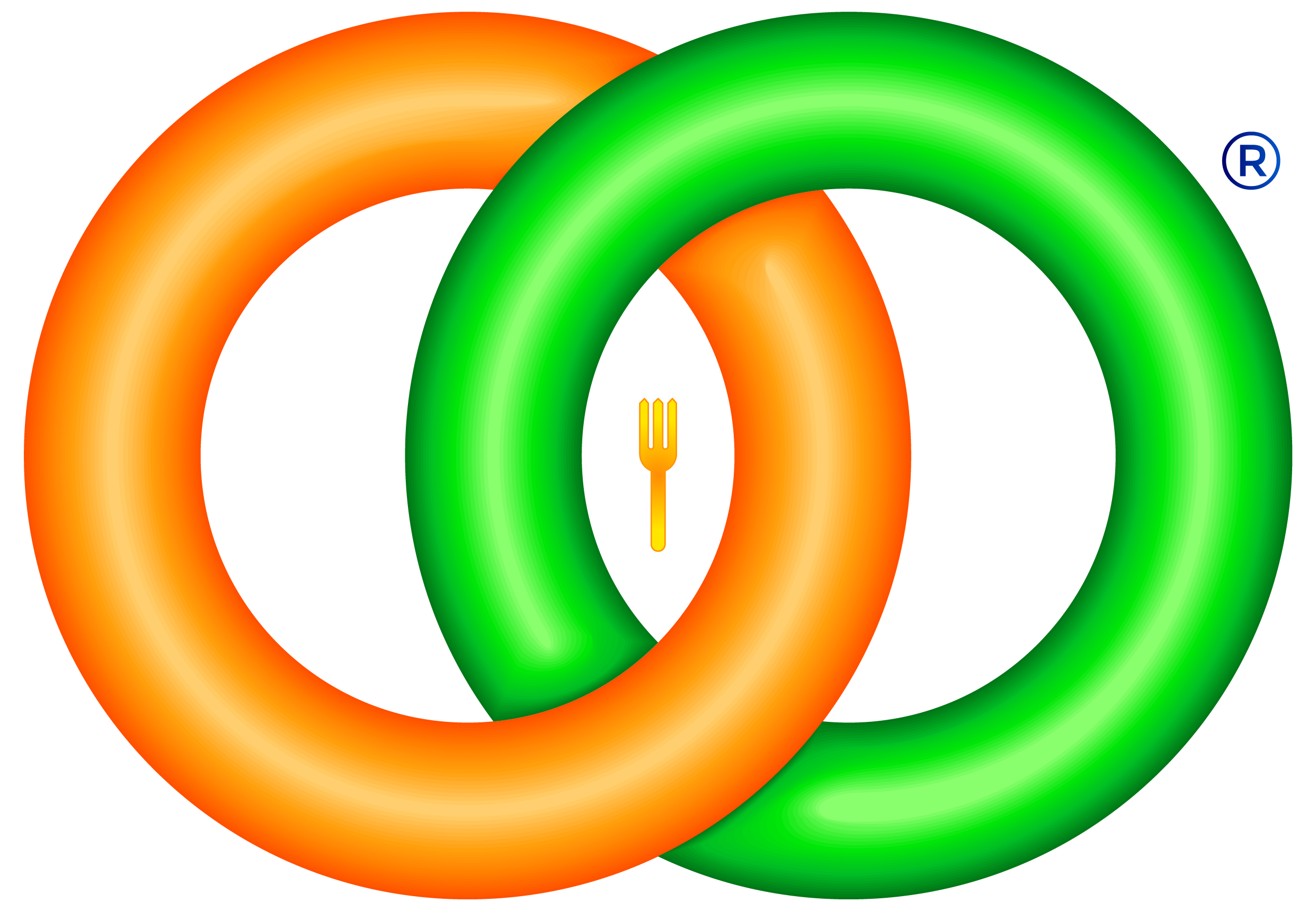
Dragonfruit-durian-tamarillo-physallis Exotic And Unique Fruits For High Profile Restaurants
Dragon fruit-Pitaya
Sweet pitayas come in three types, all with leathery, slightly leafy skin:
Sweet pitayas come in three types, all with leathery, slightly leafy skin:
Hylocereus undatus (red pitaya) has red-skinned fruit with white flesh. This is the most
commonly-seen “dragon fruit”. Hylocereus costaricensis (Costa Rica pitaya, often called H. polyrhizus) has red-skinned fruit with red flesh.Hylocereus megalanthus (yellow pitaya, formerly in Selenicereus) has yellow-skinned fruit with white flesh.
commonly-seen “dragon fruit”. Hylocereus costaricensis (Costa Rica pitaya, often called H. polyrhizus) has red-skinned fruit with red flesh.Hylocereus megalanthus (yellow pitaya, formerly in Selenicereus) has yellow-skinned fruit with white flesh.

To prepare a pitaya for consumption, the fruit is cut open to expose the flesh.The fruit’s texture is sometimes likened to that of the kiwifruit due to the presence of black, crunchy seeds.The flesh, which is eaten raw, is mildly sweet and low in calories.The seeds are eaten together with the flesh, have a nutty taste and are rich in lipids,but they are indigestible unless chewed. The fruit is also converted into juice or wine, or used to flavour other beverages. Theflowers can be eaten or steeped as tea. The skin is not eaten, and in farm-grown fruit it may be polluted with pesticides.
Durian
 In southeast Asia as the “king of fruits”, the durian is distinctive for its large size, unique odour, and formidablethorn-covered husk. The fruit can grow as large as 30 centimetres (12 in) long and 15 centimetres (6 in) in diameter, and it typically weighs one to three kilograms (2 to 7 lb). Its shape ranges from oblong to round, the colour of its husk green to brown, and its flesh pale yellow to red, depending on the species.
In southeast Asia as the “king of fruits”, the durian is distinctive for its large size, unique odour, and formidablethorn-covered husk. The fruit can grow as large as 30 centimetres (12 in) long and 15 centimetres (6 in) in diameter, and it typically weighs one to three kilograms (2 to 7 lb). Its shape ranges from oblong to round, the colour of its husk green to brown, and its flesh pale yellow to red, depending on the species.The edible flesh emits a distinctive odour, strong and penetrating even when the husk is intact. Some people regard the durian as fragrant; others find the aroma overpowering and offensive. The smell evokes reactions from deep appreciation to intense disgust, and has been described variously as almonds, rotten onions, turpentine and gym socks. The odour has led to the fruit’s banishment from certain hotels and public transportation in southeast Asia.
The durian, native to Brunei, Indonesia and Malaysia, has been known to the Western world for about 600 years. The 19th-century British naturalist Alfred Russel Wallacefamously described its flesh as “a rich custard highly flavoured with almonds”.
Tamarillo
 The fruits are egg shaped and about 4-10 centimeters long. Their color varies from yellow and orange to red and almost purple. Sometimes they have dark, longitudinal stripes. Red fruits are more acetous, yellow and orange fruits are sweeter. The flesh has a firm texture and contains more and larger seeds than a common tomato.The fruits are very high in vitamin and iron and low in calories (only about 40 calories per fruit).The fruit is eaten by scooping the flesh from a halved fruit. When lightly sugared and cooled, the flesh is used for a breakfast dish. Yellow-fruited cultivars have a sweeter flavor, occasionally compared to mango or apricot. The red-fruited variety, which is much more widely cultivated is more tart, and the savory aftertaste is far more pronounced. In the Northern Hemisphere, tamarillos are most frequently available from July until November, and fruits early in the season tend to be sweeter and less astringent.
The fruits are egg shaped and about 4-10 centimeters long. Their color varies from yellow and orange to red and almost purple. Sometimes they have dark, longitudinal stripes. Red fruits are more acetous, yellow and orange fruits are sweeter. The flesh has a firm texture and contains more and larger seeds than a common tomato.The fruits are very high in vitamin and iron and low in calories (only about 40 calories per fruit).The fruit is eaten by scooping the flesh from a halved fruit. When lightly sugared and cooled, the flesh is used for a breakfast dish. Yellow-fruited cultivars have a sweeter flavor, occasionally compared to mango or apricot. The red-fruited variety, which is much more widely cultivated is more tart, and the savory aftertaste is far more pronounced. In the Northern Hemisphere, tamarillos are most frequently available from July until November, and fruits early in the season tend to be sweeter and less astringent.Cape gooseberry-Physalis
 Physalis peruviana is closely related to the tomatillo, a fellow member of the genusPhysalis. As a member of the plant family Solanaceae, it is more distantly related to a large number of edible plants, including tomato, eggplant, and potato, and other members of the nightshades. It is not closely related to the cherry, Ribes gooseberry,Indian gooseberry, or Chinese gooseberry, as its various names might suggest.The fruit is a smooth berry, resembling a miniature spherical yellow tomato. Removed from its cape, it is about the size of a marble, say 1-2 cm in diameter. Like a tomato, it contains numerous small seeds. It is bright yellow to orange in color, and it is sweet when ripe, with a characteristic, mildly tart flavor, making it ideal for snacks, pies or jams. It is popular in salads and fruit salads, sometimes combined with avocado.
Physalis peruviana is closely related to the tomatillo, a fellow member of the genusPhysalis. As a member of the plant family Solanaceae, it is more distantly related to a large number of edible plants, including tomato, eggplant, and potato, and other members of the nightshades. It is not closely related to the cherry, Ribes gooseberry,Indian gooseberry, or Chinese gooseberry, as its various names might suggest.The fruit is a smooth berry, resembling a miniature spherical yellow tomato. Removed from its cape, it is about the size of a marble, say 1-2 cm in diameter. Like a tomato, it contains numerous small seeds. It is bright yellow to orange in color, and it is sweet when ripe, with a characteristic, mildly tart flavor, making it ideal for snacks, pies or jams. It is popular in salads and fruit salads, sometimes combined with avocado.A prominent feature is the inflated, papery calyx enclosing each berry. The calyx is accrescent; at first it is of normal size, but after the petals fall it continues to grow until it forms a protective cover round the growing fruit. Because of the fruit’s decorative appearance, it is popular in restaurants as an exotic garnish for desserts.
source and image courtesy wikepedia
